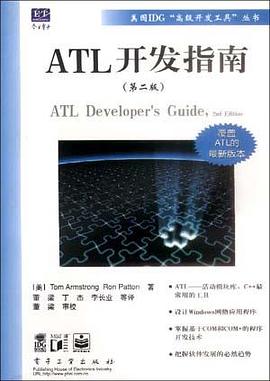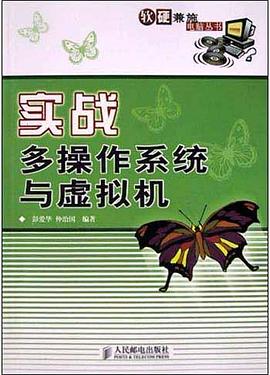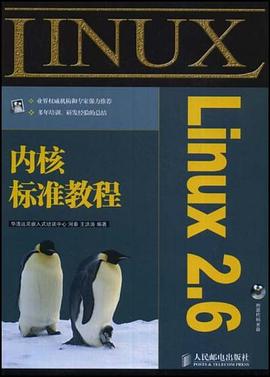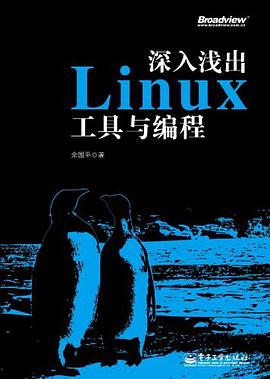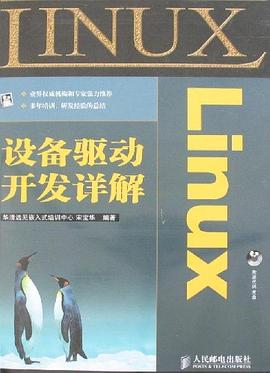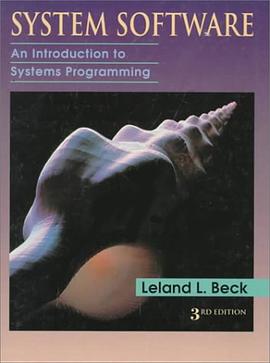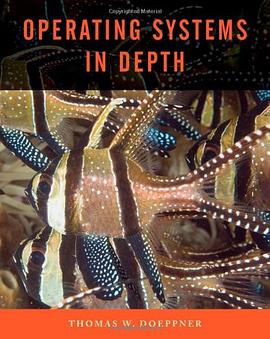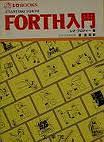

具体描述
作者简介
目录信息
CONTENTS
Introduction 1
1.1 Where Doe an Operating System
Fit in?
1.1.1 System Levels
1.2 What Does an Operating System Do?
2.1 Hardware Resources
2.2 Resource Management
2.3 Vinual Computers
A Virtual Computer
3.1 Virtual Processor
3.2 Vinual Primary Memory
3.3 Virtual Secondary Memory 10
3.4 Vinual 1/0
Do We Need an Operating System?
Summary
1.5.1 Terminotogy
1.5.2 Review Questions
1.5.3 Further Reading
1.6 Problems
2 The Hardware Interface
TheCPU
2.2 General-Purpose Register
2.3 Control Registers
2.4 Processor Modes
Instruction Set
Machine Instructions in C
Code
Memory andAddressing
Interrupts
1/0 Devices
2.4.1 Disk Controlle
Summary
2.5.1 Terminotogy
2.5.2 Review Questions
2.5.3 Further Reading
2.6 Problems
3 The Operating System Interface
3.1 What Are System Calls?
3.1.1 How to Make a System Call
3.1.2 What Is a System Call Interface?
3.2 An Example System Call Interface
3.2.1 Syslem Call Overview
3.2.2 Hierarchical File Naming
Syslems
3.2.3 File and 1/o Svstem Calls
3.2.4 Open Files
3.3
3.4
3.5
3.2.5 Examples of File 1/0
Infonnation and Meta-Information
Naming Operating System Objects
3.5 Devices as Files
3.5.1 Unificalion of the Fil and Devi
Concepts
3.6 The Process Concept
3.6.1 Processes and Programs
3.6.2 Process Management System
Calls
3.7
3.6.3 Process Hierarchy
Communication between Processes
3.7.1 Communication-Related System
Calls :
3.7.2 Example of Inlerproces.-
3.8 UNIX-Style Process Creation
3.9 Standard Input and Standard Output
Communication
3.10 Communicating with Pipes
3.10.1 Naming of Pipes and Message
Queues
3.11 Summary of System Call Interface
3.12 Operating System Exampies
3.12.1 UNIX
3.12.2 Mach
3.12.3 MS/DOS
3.12.4 Windows NT
3.12.5 os/2
3.12.6 Macinlosh OS
3.13 The User Interface to an Operating
System*
3.13.1 Why You Need a Shell
3.13.2 TheSpecificationoftheShell
3.13.3 Implementing the Shell
3.14 Summary
3.14.1 Terminology
3.14.2 Review Questions
3.14.3 Further Reading
3.15 Problems
Design Techniques 1
4.1 Operating Systems and Design
4.1.1 The Design Process
4.1.2 Relationship to Software
Engineering
4.1.3 A Design Example
4.1.4 Leaming Design through Operating
Systems
4.2 Design Problems
4.2.1 DesignSkills
4.2.2 Design Space
4.2.3 Design Levels
4.3 Design Techniques
4.4 Two-Level Implementation
4.4.1 Overview
4.4.2 Motivation
4.4.3 Operating System Examples
4.4.4 Computer Science Examples
4.4.5 Applicability
4.4.6 Consequences
4.4.7 Implementation Issue and
Variations
4.4.8 Related Design Techniques
4.5 Interface Design
4.5.1 Overview
4.5.2 Motivatior
4.5.3 Applicability
4.5.4 Consequences
4.5.5 Related Design Technique
4.6 Connection in Protocols
4.6.1 Overview
4.6-2 Motivation
4.6.3 Operating System Exampies
4.6.4 Computer Science Examples
4-6.5 Applicabilily
4.6.6 Consequences
4.6.7 Implementation Issue and
Variations 102
4.6.8 Related Design Technique
4.7 Interactive and Programming
Interfaces
4.7.1 Overview
4.7.2 Motivation
4.7.3 Operating Syslem Examples
4.7.4 Compucer Science Examples
4.7.5 Applicability
4.7.6 Consequences
4.7.7 Implementation Issue -and
Variations
4.7.8 Related Design Techniques
4.8 Decomposition Pattems
4.8.1 Overview
4.8.2 Mocivalion
4.8.3 Operating System Examples
4.8.4 Computer Science Examples
4.8.5 Applicability
4.8.6 Consequences
4.8.7 Implementation Issue. and
Varialions
4.8.8 Related Design Technique
4.9 Summary
4.9.1 Terminology
4.9.2 Review Question
4.10 Problems
Implementing Processes
5.1 The System Call Interface
5.2 Implementation of a Simple Operating
System 119
5.2.1 Guide to the Code
5.2.2 The Architecture
5.2.3 System Constants
5.2.4 Global Data
5.3 Implementation of Processes
5.3.1 Process Creation
5.3.2 Process States
5.3.3 Process Dispatching
5.3.4 The System Stack
5.3.5 Timer Intemupts
5.4 System Initialization
5.4.1 The Initial Process
5.5 Process Switching
5.5.1 Swilching between Processe
5.5.2 Flow of Conlrol
System Call Interrupt Handling
5.6.1 Copying Messages between Addres
Spaces
5.7 Program Brror Interrupts
5.8 Disk Driver Subsystem
5.8.1 Communicating with the Disk
5.9 Conlroller
Implementation of Waiting
5.9.1 Waiting for Messages
5.9.2 Waiting inside a System Call
5.9.3 Suspending System Calls
Flow of Control through the Operating
5.10 System
5.11 Signaling in an Operating System
5.12 Interupts in the Operating System
5.13 Operating Systems as Event and Table
Managers
5.14 Process Implementation
5.14.1 The Process Table and Proces
5.15 Descriptors
5.16 Examples ofProcess Implementation
Monoprogramming*
5.16.1 BatchSystems
5.16.2 Multiprogramming and 1/o
Overlap
5.16.3 Personal Computer System
5.17Summary
5.17.1 Tenninology
5.17.2 Review Questions
5.17.3 Further Reading
Problems
Parallel Systems
6.1 Parallel Hardware
6.2 An Operaling System fo a Two-Processo
System
6.2.1
Using Two Separate Operating
Syslems
6.2.2 Sharing the Operating Syslem
6.3 Race Conditions with a Shared Proces.
Table
6.4 Atomic Actions
6.4. i Hardware ImDlementation of Atomic
Actions
6.5 A Multiprocessor Operating System
6.5.1 The Current Process Variable
6.5.2 Dispatching With a Shared Process
Table
6.5.3 Busy Waiting
6.5.4 Handling the Queues
6.5.5 Grouping of Shared Variables
6.5.6 A General Solution
6.5.7 Using Two Process Tables
Examples of Multiprocessor Operating
6.6 Systems
6.7. Threads
6.7.1 The Thread Concept
6.7.2 Thread Syslem Calls
6.7.3 Advantages ofThreads
6.7.4 U.sesofThreads
6.7.5 Thread Implementation*
6.7.6 Splitting Ihe Process Concepl
6.7.7 Lightweight Processes and Use
Threads
6.7.8 Examples of Threads
6.8 Kernel-mode Processes*
6.8.1 Data Struclures for Kernel-Mod
Processes
6.8.2 Process Creation with Kemel-Mode
Processes
6.8.3 Interrupt Handler for Kemel-Mod
Processes
6.8.4 Switching Processe for Kernel-Mod
Processes
6.8.5 How the System Slack is Used
6.8.6 Wailing wilh Kemel-Mode
Processes
6.8.7 Dispatching with Kernel-Mod
Processes
6.8.8 Kemel-Mode only Processe,
6.8.9 Trade-Ofts otKemel-Mode
Processes
6.8.10 Examples uf Kemel-Mode
Processes
6.9 Implementation of Mutual Exclusion
6.9.1 First Solulion: Disabling
Interrupts
6.9.2 Second Solution: Usinc
ExchungeWord
6.9 3 Third Solulion: Sottware
Solutions
6.9.4 When to Use Each Solution
6.9.5 Examples ot' Implemenling Mulual
Exclusiun
Varieties ofComputer Model
6.10.1 Multiprogramming
6.10.2 Mulliprocessing
Summary
6.11.1 Tcrminoiogy
6.11.2 Review Questions
6.11.3 Furher Reading
Problems
Interprocess Communication
Pattems
7.1 Using Interprocess Communication
7.2 Pattems of Interprocess
Communication
7.2.1 Competing and Cooperating
7.3 Problems When Processes Compete
7.4 Race Conditions and Atomic Actions
7.5 New Message-Passing System Calls
7.6 IPC Pattem: Mutual Exclusion
7.6.1 N Process Mutual Exclusion
7.6.2 Voluntary Cooperation in Mutual
Exclusion
7.7 IPC Pattem: Signaling
7.8 IPC Pattem: Rendezvous
7.8.1 Many Process Rendezvous
7.9 IPC Pattem: Producer-Consumer
7.9.1 The Basic Producer-Consumer
Pattem
7.9.2 Limiting the Numbe of Buffer
LIsed
7.9.3 Multiple Producer and
Consumers
7.10 IPC Pattem: Client-Server
7.11 IPC Pattem: Multiple Servers and
Clients*
7.12 IPC Pattem: Database Acces. and
Update
7.12.1 Scheduling
7.12.2 Priorily
7-12.3 Scheduling Queues
7.13 Review of Interprocess Communication
Pattems
7.13.1 Mutual Exclusion
7.13.2 Signaling
7.13.3 Rendezvous
7.13.4 Producer-Consume
7.13.5 Clienl-Server 264
7.13.6 Multiple Servers and Clients
7.13.7 Database Access and Update
7.14 A Physical Analogy
7.15 Failure of Processes
7.15.1 Recovery from Failure
7.16 Summary
7.16.1 Terminology
7.16.2 Review Questions
7.16.3 Funher Reading
7.17 Problems
Processes
8.1 Everyday Scheduling
8.1.1 First-Come, First-Served
Scheduling
Shortest-Job-First Scheduling
Highest-Response-Ratio-Next
Scheduling
Priority Scheduling
Deadline Scheduling
8.1.6 Round-Robin Scheduling
8.1.7 Summary
8.2 Preemptive Scheduling Methods
8.2.1 Scheduling Overview
8.2.2 Round-Robin Scheduling
8.2.3 Heavily Loaded Systems
8.2.4 Two Queues
8.2.5 Multiple Queues
8.3 Policy versus Mechanism in
Scheduling
8.4 A Scheduling Example
8.5 Scheduling in Real Operating
Systems
8.5.1 Scheduling in UNIX SVR4
8.5.2 Scheduling in Solaris
8.5.3 Scheduling in 0S/22.0
8.5.4 Schedu]inginWindowsNT3.51
8.5.5 Scheduiing in Other Operating
Systems
8.6 Deadlock
8.7 Why Deadlock Is a Problem
8.8 Conditions for Deadlock to Occur
8.9 How to Deal with Deadlock
8.9.1 Deadlock Prevention
8.9.2 Deadlock Avoidance
8.9.3 Deadlock Recovery
8.10 A Sequence ofApproache to the Deadlock
Problem
8.11 Two-Phase Locking
Starvation
8.12 Message Passing Variations
8.13.1 Using PIDs as Message
Addresses
8.13.2 Message Passing with Nonblocking
Receives
8.13.3 Message Passing with Blocking
Sends
8.13.4 Remole Procedure Call,
8.14 Synchronization
8.14.1 DeftnitionofSynchronization
8.14.2 Review of Synchronization
8.15 Separating Data Transfer and
8.16 Synchronization
Semaphores
8.16.1 Specification ot' Semaphore
Operations
8.16.2 Implementation ot Semaphore
8.16.3 AnAnalogy
8.16.4 Mutual Exctusion with
Semaphores
8.16.5 Rendezvous with Semaphores
8.16.6 Producer-Consumer (one buffer) wilh
Semaphores
8.16.7 Counting Semaphores
8.16.8 Producer-Consumer(N buffers) wiih
Semaphore.s
8.16.9 Semaphores and Message.
8.17 Implementing Semaphores*
8.17.1 Sy.stem Constants
Using Semaphores in the Simple Operaling
System
8.18 Programming-Language-Based
8.19 Synchronization Primitives
8.19.1 Monilors
8.19.2 Synchronizalion Primitives in
Ada 95
8.20 Message Passing Design Issues
8.20.1 Copying Messages
8.20.2 Longer Messages
8.21IPC in Mach 337
8.21.1 Tasks and Threads
8.21.2 Ports and Messages
8.21.3 Objects
8.22 IPC and Synchronizalion Example.
8.22.1 Signals 338
8.22.2 SVR4 UNIX
8.22.3 Windows NT
8.22.4 0S/2
8.22.5 Solaris
8.23 Summary
8.23.1 Terminology
8.23.2 ReviewOuestions
8.23.3 Funher Reading
8.24 Problems
Design Techniques 11
Indirection
Overview
9.1 Motivation
9.1.1 Operating System Examples
9.1.2 Computer Science Examples
9.1.3 Discussion
9.1.4 Applicability
Consequences
9.2 Using State Machines
9.2.1 Overview
9.2.2 Operating System Example .
9.2.3 Computer Science Example
9.2.4 Applicabilily
9.2.5 Consequences
9.2.6 Implementation Issue, and
Variations
9.3 Win Big. Then Give Some Back
9.3.1 Overview
9.3.2 Motivation
9.3.3 Operating System Examples
9.3.4 Computer Science Examples
9.3.5 Applicability
9.4 Consequences
Separation ot Concepts
9.4.1 Overview
9.4.2 Molivation
9.4.3 Operating Syslem Examples
9.4.4 Computer Science Examples
9.4.5 Applicability
9.4.6 Consequences
9.4.7 Implementation Issue and
9.4.8 Related Design Techniques .
Variations
9.5 Reducing a Problem to a Specia'. Case
9.5.1 Overview
9.5.2 Motivation
9.5.3 Operating System Examples
9.5.4 Computer Science Examples
9.5.5 Applicability
9.5.6 Consequences
9.5.7 Implementation Issue and
Variations
9.6 Reentrant Programs
9.6.1 Overview
9.6.2 Motivacion
9.6.3 Operaling System Examples
9.6.4 Computer Science Examples
9.6.5 Applicability
9.6.6 Consequences
9.6.7 Implementation Issue and
Variations
9.6.8 Related Design Techniques
9.7 Using Models for Inspiration
9.7.1 Overview
9.7.2 Motivation
9.7.3 Operating System Examples
9.7.4 Computer Science Examples
9.7.5 Applicability
9.7.6 Consequences
9.8 Adding a New Facility to a System
9.8.1 Overview
9.8.2 Motivation
9.8.3 Operating System Examples
9.8.4 Computer Science Examples
9.8.5 Applicability
9.8.6 Consequences
9.8.7 Related Design Technique.
9.9 Summary
9.9.1 Tenninology
9.9.2 Review Question
9.10 Problems
Memory Management
10.1 Levels of Memory Management
10.2 Linking and Loading a Process
10.2.1 Creating a Load Module
10.2.2 Loading a Load Module
10.2.3 Allocating Memory in a Running
PTocess
10.3 Variations in Program Loading
10.3.1 Load Time Dynamic Linking
10.3.2 Run Time Dynamic Linking
10.4 Why Use Dynamic Memory
Allocation?
10.5 The Memory Management Design
Problem*
10.6 Solutions to the Memory Management
Design Problem*
10.6.1 Static Division into a Fixed Numbe
of Blocks
10.6.2 Buddy Syslems
10.6.3 Powers-of-two Allocation
10.7 Dynamic Memory Allocation*
10.8 Keeping Track of the Blocks*
10.8.1 The List Method
10.8.2 Keeping Allocated Blocks on the
Block List
10.8.3 Where Is che Block List Kept?
10.8.4 Using Block Headers as Free List
Nodes
10.8.5 The Bitmap Method
10.8.6 Comparing Free List Methods
10.9 Which Free Block to Allocate?*
10.10 Examples of Dynamic Memory
Allocalion
10.11 Logical and Physical
Memory
10.12 Allocating Memory to
Processes
10.12.1 Static Memory Management
10.12.2 Handling Variable-Sized
Processes
10.13 Multiprogramming Issues
10.14 Memory Protection
10.15 Memory Management System Calls
10.15.1 Static Allocation of Memory lo
Processes
10.15.2 Dynamic Allocation of Memory to
Processes
10.15.3 What about New and Malloc?
10.15.4 Freeing Memory at Each
Leve
10.15.5 ADifferent Memory Management
System Call
10.16 Example Code for Memory
Allocation*
10.17 Summary
10.17.1 Terminology
10.17.2 Review Question
10.17.3 Funher Reading
10.18 Problems
Virtual Memory
11.1 Fragmentation and Compaction*
11.2 Dealing with Fragmentation
11.2.1 Separate Code and Data Spac
11.2.2 Segments
11.2.3 Noncontiguous Logieal Addres
Spaces
11.2.4 Page Tables in Hardwar
Registers
11.2-5 Page Tables in Memory
11.2.6 Using a Page Table Cache
11.2.7 Analysis Models of Paging with
Caching
11.2.8 Memory Allocation with Paging
11.2.9 Tenninology: Page and Page
Frame
11.2.10 PageTahles
11.2.11 Paging Summary
11.3 Memory Allocalion Code wilh Page.
11.4 Sharing the Processor and Sharing
Memory*
11.5 Swapping*
11.5.1 Efficient Resource Use and Vse
Needs
11.6 Overlays*
11.6.1 Overlays in PCs
11.7 Implemenling Virtual Memory
11.7.1 Hardware Required to Supporl Virtal
Memory
11.7.2 Software Required to Support Virtual
Memory
11.8 What is the Cost of Virtual Memory'?
11.8.1 Paging More Than One Process
11.8.2 Locality
11.9 Virtual Memory Management
11.10 Daemons and Events
11.11 File Mapping
11.11.1 The System Call Intert'ace
11.11.2 An Example of Using File
Mapping
11.11.3 Advanfages of File Mapping
11.11.4 Memory and File Mapping on the
IBM 801
11.11.5 File Mapping Example.
11.12 Summary
11.12.1 Tenninology
11.12.2 Review Questions
11.12.3 Further Reading
11.13 Problems
12 Virtual Memory Systems
12.1 Page Replacement
12.2 Global Page Replacement Algorithms
12 2.1 easuring the Performance of a Page
12.2.2 Replacement Algorithm
12.2.3 Optimal Page Replacement
12.2.4 Theories of Program Paging
12.2.5 Behavior
Random Page Replacement
First-In. First-Out FIFO Page
Replacernenl
Least Recenlly Used Pag
Replacement
12.2.7 Approximations ot'LRU
12.2.8 Clock Algorithms
12.3 Page Replacement Examples
12.4 Local Page Replacement Algorithm.
12.4.1 What Is a Working Set?
12.4.2 Program Phases
12.4.3 Varlable Resident Set Size.
12.4.4 The Working Sel Paging
Algorilhm
12.4.5 Approximating ine working Set
12.4.6 WSCIock Paging Algorithm
12.5 Evaluating Paging Algorithms*
12.5.1 Methodology for Paging
Simulation
12.5.2 Some Page Simulation Result
12.6 Thrashing and Load Control
12.6.1 How Thrashing Occurs
12.6.2 Load control
12.6.3 Swapping
12.6.4 Scheduling and Swapping
12.6.5 Load Control and Paging
Algorithms
12.6.6 Predictive Load Control
12.6.7 Preloading of Pages
12.7 Dealing with Large Page Tables
12.7.1 What Is the Problem?
12.7.2 Two-Level Paging
12.7.3 Benefits of Two-LevelPaging
12.7.4 Problems with Two-Level
Paging
12.7.5 Software Page Table Lookup.
12.8 Recursive Address Spaces*
12.9 Paging the Operating System Addres.
Space
12.9.1 Locking Pages in Memory
12.10 PageSize*
12.10.1 Reasons for a Large Page Size
12.10.2 Reasons for a Small Page Size
12.10.3 Clustering Pages
12.11 Segmentation
12.11.1 What Is a Segment?
12.11.2 Vinual Memory with
Segmentation
12.11.3 Segmentation with Paging
12.11.4 History of Segmenlation
12.11.5 Segment Tenninology
12.12 Sharing Memory
12.12.1 Reasons for Sharing Memory
12.12.2 Shared Memory Sysiem Calls
12.13 Examples of Virtual Memory Systems
12.13.1 SwapArea
12.13.2 Page Initialization
12.13.3 PageSharing
12.13.4 Double-Handed Clock
Algorithm
12.13.5 Standby Page Lists
12.13.6 Clustering Pages
12.13.7 FileMapping
12.13.8 Portable Virtual Memory
Systems
12.13.9 Sparse Address Space
12.13.10 OS/2 Version 2.0
12.13.11 WindowsNT
12.13.12 Mach and OSF/1
12.13.13 System V Release 4
12.13.14 Other Systems
12.14 Very Large Address Spaces
12.15 Summary
12.15.1 Terminology
12.15.2 Review Queslions
12.15.3 Funher Reading
12.16 Problems
13Design Techniques III
13.1 Multiplexing
13.1.1 Overview
13.1.2 Motivation
13.1.4
Operatmg System Examples
Computer Science Examples
Applicability
Consequences
13.2 Late Binding
13.2.1 Overview
13.2.2 Motivation
13.2.3 Operating System Examples
13.2.4 Computer Science Examples
13.2.5 Applicability
13.2.6 Consequences
13.2.7 Implementation Issue. and
Variations
13.2.8 Related Design Technique
13.3 Static Versus Dynamic
13.3.1 Overview
13.3.2 Molivation
13.3.3 Operating System Examples
13.3.4 Computer Science Examples
13.3.5 Applicabilily
13.3.6 Consequences
13.3.7 Implementation Issue and
Variations
13.3.8 Related Design Technique
Space-Time Tradeoffs
13.4
13.4.1 Overview
13.4.2 Motivation
13.4.3 Computer Science Example
13.4.4 Applicability
13.4.5 Consequences
13.4.6 Implemenlation Issue and
Variations
13.4.7 Related Design Technique
13.5 Simple Analytic Models
13.5.1 Overview
13.5.2 Molivation
13.5.3 Operating System Example.
13.5.4 Applicability
13.5.5 Consequences
13.5.6 Implementation Issue and
Variations
13.6 Surnmary
13.6.1 Terminology
13.6.2 Review Queslion.
Problems
1/0 Devices
14.1 Devices and Controllers
14.1.1 Device Conlrollers
14.2 Terminal Devices*
14.2.1 Basic Terminals
14.2.2 Di.splay Commaius
14.2.3 Example Disptay Command.
14.2.4 Keyboard Event.s
14.2.5 Terminal Capability Database.
14.2.6 Vinual Tenninals
14.2.7 Terminal Intertaces
14.2.8 MouseDevices
14.2.9 Event Streams
14.2.10 Varieties ol'Two-
Proecsing
14.2.11 Graphics Terminals
14.2.12 Color and Color Maps
14.2.13 Command Oriented Graphic
14.2.14 X Temnals
14.2.15 Terminai Emulators
14.2.16 Virlual Terminals and Termina!
Emulators
14.2.17 PPP; a Nelwork EmulatDr
14.2.18 Modems
14.3 Communicalion Devices*
14.3.1 Serial Pons
14.3.2 Parallel Ports
14.3.3 Elhemef Devices
14.3.4 Other NetworkDevices
14.4 DiskDevices
14.4.1 Timing ot' a Disk Access
14.4.2 Floppy Dislts
14.4.3 RAIDDevices
14.5 Disk Controllers
14.6 SCSI Interfaces*
14.7 Tape Devices*
14.8 CDDevices*
14.9 Summary
14.9.1 Temiinology
14.9.2 Review Question
14.9.3 Funher Reading
14.10 Problems 613
15 1/0 Systems
15.1 1/0 System Software
15.1.1 Device Drivers
15-1.2 Device Driver Interfaces
15-1,3 The Two Categorie.s of Device
Drivers
15.1.4 The Block Device Inlert'ace
15.1.5 The Character Devicc Inlerface
15 1.6 Disk Device Driver Access Slrategies
15.2 Handling Disk Requests
15.2.1 Efficienily
15.2.2 Double Buffering -- An Aside
15.2.3 A Disk Scheduling Example
15.2.4 Sector Scheduling within Cylinder
Scheduling
15.2.5 Comhined Sectorand Cylinde
Schcduling
15.2.6 Real-Life Disk Head Scheduling
15.3 Modeling of Disks*
15.3.1 A Disk Scheduling Anomaly
15.3.2 Cylinder Correlations
15.3.3 A More Accurate Disk Model
15.4 Device numbers
15.5 Unification of Files and I/O Devices
15.6 Generalized Disk Device Drivers
15.6.1 Parlilioning Large Disks
15.6.2 romhining Disks into a Large
Logical Disk
15.6.3 RAMDisks
15.6.4 Memory as a Devic
15.6.5 Pseudo-ttys
15.7 DiskCaching
15.8 Two-Level Structure of Device
Drivers
15.9 SCSl Device Drivers
15.10 Examples of 1/0 Systems
15.11 Summary
15.11.1 Temlinology
15.11.2 Review Questions
15.11.3 Funher Reading
l.12 Problems
19.8.2 System Authentication
19.8.3 Other Methods ofAuthentication
19.8.4 Password Varianls
19.8.5 Identifying Objects
19.8.6 Identifying a Person
Mechanisms for Protecting Hardware
19.9 Resources
19.9.1 Processor Modes
19.9.2 Prolecting Hardware Resource
Representation of Protection
19.10Information
19.10.1 ObjectTypes
19.10.2 Operations On Objects
19.10.3 The Protection Database
19.10.4 Access Control Lists
19.10.5 Capability Lists
19.10.6 Modifying the Protection
Database
19.10.7 Protection Domains
19.10.8 Protection in Distributed Systpm
19.10.9 Caching Protection Data
19.10.10 Operations on Protection Objects
19.11Mechanisms for Software Protection
19.11.1 File Protection Example
19. i 1.2 Implementation of Protection
19.11.3 Protection Mechanisms and Securit
Policies 799
19.11.4 Variations in File Security
19.12 Examples of Protection Attacks
19.12.1 Browsing for Infonnation
19.12.2 Wiretapping of Communication
Lines
19.12.3 Trial and Error
19.12.4 Password Guessing
19.12.5 Searching Trash
19.12.6 TrapDoors
19.12.7 Running Other Peopl
Programs
Govemment Security Level
19.14 Protection Examples
19.14.1 Protection In Windows NT
19.14.2 Protection In OSF/l
19.14.3 Protection In UNIX
19.15 Extemal Security
19.15.1 Physical Security
19.15.2 Operational Security
19.15.3 NonTechnical Security Threats
The Use of Cryptography in Computer
19.16 Security
19.16.1 What Is Cryptography?
19.16.2 Some Basic Definition
19.16.3 Public and Private Key
Cryptosystems
19.16.4 Using Cryptography for Privac
19.16.5 Using Cryptography for
Authentication
19.16.6 Authenticating Public Key
19.17 Summary
19.17.1 Terminiogy
19.17.2 Review Questions
19.17.3 Further Reading
19.18 Problems
20 The Client-Server Model
20.1 Three Modes of Communication
20.2 System Processes
20.2.1 Overview
20.2.2 The Initial Process
20.2.3 System Constants
20.2.4 Initialization
20.2.5 Inlerrupt Handling
20.2.6 Handling System Calls
20.2.7 The System Call Handling Code
20.2.8 User Knowledge of Message Queu
Identifiers
20.2.9 Protection of Resources
20.2.10 Disk Intemupt Handler
20.2.11 Disk 1/0 System Process
20.2.12 Server Data Structures
20.3 Micro-Kemel Operating Systems
20.3.1 Tradeoffs of the Client Server
Model
20.3.2 Object-Oriented Operating
Systems
20.4 The Developments toward a Distributed
System
20.4.1 Networked Operating Systems
20.4.2 Distributed Operating Systems
20.5 Summary
20.5.1 Terminology
20.5.2 Review Questions
20.5.3 Funher Reading
20.6 Problems
Glossary G-l
References R-1
Index 1-1
· · · · · · (收起)
Introduction 1
1.1 Where Doe an Operating System
Fit in?
1.1.1 System Levels
1.2 What Does an Operating System Do?
2.1 Hardware Resources
2.2 Resource Management
2.3 Vinual Computers
A Virtual Computer
3.1 Virtual Processor
3.2 Vinual Primary Memory
3.3 Virtual Secondary Memory 10
3.4 Vinual 1/0
Do We Need an Operating System?
Summary
1.5.1 Terminotogy
1.5.2 Review Questions
1.5.3 Further Reading
1.6 Problems
2 The Hardware Interface
TheCPU
2.2 General-Purpose Register
2.3 Control Registers
2.4 Processor Modes
Instruction Set
Machine Instructions in C
Code
Memory andAddressing
Interrupts
1/0 Devices
2.4.1 Disk Controlle
Summary
2.5.1 Terminotogy
2.5.2 Review Questions
2.5.3 Further Reading
2.6 Problems
3 The Operating System Interface
3.1 What Are System Calls?
3.1.1 How to Make a System Call
3.1.2 What Is a System Call Interface?
3.2 An Example System Call Interface
3.2.1 Syslem Call Overview
3.2.2 Hierarchical File Naming
Syslems
3.2.3 File and 1/o Svstem Calls
3.2.4 Open Files
3.3
3.4
3.5
3.2.5 Examples of File 1/0
Infonnation and Meta-Information
Naming Operating System Objects
3.5 Devices as Files
3.5.1 Unificalion of the Fil and Devi
Concepts
3.6 The Process Concept
3.6.1 Processes and Programs
3.6.2 Process Management System
Calls
3.7
3.6.3 Process Hierarchy
Communication between Processes
3.7.1 Communication-Related System
Calls :
3.7.2 Example of Inlerproces.-
3.8 UNIX-Style Process Creation
3.9 Standard Input and Standard Output
Communication
3.10 Communicating with Pipes
3.10.1 Naming of Pipes and Message
Queues
3.11 Summary of System Call Interface
3.12 Operating System Exampies
3.12.1 UNIX
3.12.2 Mach
3.12.3 MS/DOS
3.12.4 Windows NT
3.12.5 os/2
3.12.6 Macinlosh OS
3.13 The User Interface to an Operating
System*
3.13.1 Why You Need a Shell
3.13.2 TheSpecificationoftheShell
3.13.3 Implementing the Shell
3.14 Summary
3.14.1 Terminology
3.14.2 Review Questions
3.14.3 Further Reading
3.15 Problems
Design Techniques 1
4.1 Operating Systems and Design
4.1.1 The Design Process
4.1.2 Relationship to Software
Engineering
4.1.3 A Design Example
4.1.4 Leaming Design through Operating
Systems
4.2 Design Problems
4.2.1 DesignSkills
4.2.2 Design Space
4.2.3 Design Levels
4.3 Design Techniques
4.4 Two-Level Implementation
4.4.1 Overview
4.4.2 Motivation
4.4.3 Operating System Examples
4.4.4 Computer Science Examples
4.4.5 Applicability
4.4.6 Consequences
4.4.7 Implementation Issue and
Variations
4.4.8 Related Design Techniques
4.5 Interface Design
4.5.1 Overview
4.5.2 Motivatior
4.5.3 Applicability
4.5.4 Consequences
4.5.5 Related Design Technique
4.6 Connection in Protocols
4.6.1 Overview
4.6-2 Motivation
4.6.3 Operating System Exampies
4.6.4 Computer Science Examples
4-6.5 Applicabilily
4.6.6 Consequences
4.6.7 Implementation Issue and
Variations 102
4.6.8 Related Design Technique
4.7 Interactive and Programming
Interfaces
4.7.1 Overview
4.7.2 Motivation
4.7.3 Operating Syslem Examples
4.7.4 Compucer Science Examples
4.7.5 Applicability
4.7.6 Consequences
4.7.7 Implementation Issue -and
Variations
4.7.8 Related Design Techniques
4.8 Decomposition Pattems
4.8.1 Overview
4.8.2 Mocivalion
4.8.3 Operating System Examples
4.8.4 Computer Science Examples
4.8.5 Applicability
4.8.6 Consequences
4.8.7 Implementation Issue. and
Varialions
4.8.8 Related Design Technique
4.9 Summary
4.9.1 Terminology
4.9.2 Review Question
4.10 Problems
Implementing Processes
5.1 The System Call Interface
5.2 Implementation of a Simple Operating
System 119
5.2.1 Guide to the Code
5.2.2 The Architecture
5.2.3 System Constants
5.2.4 Global Data
5.3 Implementation of Processes
5.3.1 Process Creation
5.3.2 Process States
5.3.3 Process Dispatching
5.3.4 The System Stack
5.3.5 Timer Intemupts
5.4 System Initialization
5.4.1 The Initial Process
5.5 Process Switching
5.5.1 Swilching between Processe
5.5.2 Flow of Conlrol
System Call Interrupt Handling
5.6.1 Copying Messages between Addres
Spaces
5.7 Program Brror Interrupts
5.8 Disk Driver Subsystem
5.8.1 Communicating with the Disk
5.9 Conlroller
Implementation of Waiting
5.9.1 Waiting for Messages
5.9.2 Waiting inside a System Call
5.9.3 Suspending System Calls
Flow of Control through the Operating
5.10 System
5.11 Signaling in an Operating System
5.12 Interupts in the Operating System
5.13 Operating Systems as Event and Table
Managers
5.14 Process Implementation
5.14.1 The Process Table and Proces
5.15 Descriptors
5.16 Examples ofProcess Implementation
Monoprogramming*
5.16.1 BatchSystems
5.16.2 Multiprogramming and 1/o
Overlap
5.16.3 Personal Computer System
5.17Summary
5.17.1 Tenninology
5.17.2 Review Questions
5.17.3 Further Reading
Problems
Parallel Systems
6.1 Parallel Hardware
6.2 An Operaling System fo a Two-Processo
System
6.2.1
Using Two Separate Operating
Syslems
6.2.2 Sharing the Operating Syslem
6.3 Race Conditions with a Shared Proces.
Table
6.4 Atomic Actions
6.4. i Hardware ImDlementation of Atomic
Actions
6.5 A Multiprocessor Operating System
6.5.1 The Current Process Variable
6.5.2 Dispatching With a Shared Process
Table
6.5.3 Busy Waiting
6.5.4 Handling the Queues
6.5.5 Grouping of Shared Variables
6.5.6 A General Solution
6.5.7 Using Two Process Tables
Examples of Multiprocessor Operating
6.6 Systems
6.7. Threads
6.7.1 The Thread Concept
6.7.2 Thread Syslem Calls
6.7.3 Advantages ofThreads
6.7.4 U.sesofThreads
6.7.5 Thread Implementation*
6.7.6 Splitting Ihe Process Concepl
6.7.7 Lightweight Processes and Use
Threads
6.7.8 Examples of Threads
6.8 Kernel-mode Processes*
6.8.1 Data Struclures for Kernel-Mod
Processes
6.8.2 Process Creation with Kemel-Mode
Processes
6.8.3 Interrupt Handler for Kemel-Mod
Processes
6.8.4 Switching Processe for Kernel-Mod
Processes
6.8.5 How the System Slack is Used
6.8.6 Wailing wilh Kemel-Mode
Processes
6.8.7 Dispatching with Kernel-Mod
Processes
6.8.8 Kemel-Mode only Processe,
6.8.9 Trade-Ofts otKemel-Mode
Processes
6.8.10 Examples uf Kemel-Mode
Processes
6.9 Implementation of Mutual Exclusion
6.9.1 First Solulion: Disabling
Interrupts
6.9.2 Second Solution: Usinc
ExchungeWord
6.9 3 Third Solulion: Sottware
Solutions
6.9.4 When to Use Each Solution
6.9.5 Examples ot' Implemenling Mulual
Exclusiun
Varieties ofComputer Model
6.10.1 Multiprogramming
6.10.2 Mulliprocessing
Summary
6.11.1 Tcrminoiogy
6.11.2 Review Questions
6.11.3 Furher Reading
Problems
Interprocess Communication
Pattems
7.1 Using Interprocess Communication
7.2 Pattems of Interprocess
Communication
7.2.1 Competing and Cooperating
7.3 Problems When Processes Compete
7.4 Race Conditions and Atomic Actions
7.5 New Message-Passing System Calls
7.6 IPC Pattem: Mutual Exclusion
7.6.1 N Process Mutual Exclusion
7.6.2 Voluntary Cooperation in Mutual
Exclusion
7.7 IPC Pattem: Signaling
7.8 IPC Pattem: Rendezvous
7.8.1 Many Process Rendezvous
7.9 IPC Pattem: Producer-Consumer
7.9.1 The Basic Producer-Consumer
Pattem
7.9.2 Limiting the Numbe of Buffer
LIsed
7.9.3 Multiple Producer and
Consumers
7.10 IPC Pattem: Client-Server
7.11 IPC Pattem: Multiple Servers and
Clients*
7.12 IPC Pattem: Database Acces. and
Update
7.12.1 Scheduling
7.12.2 Priorily
7-12.3 Scheduling Queues
7.13 Review of Interprocess Communication
Pattems
7.13.1 Mutual Exclusion
7.13.2 Signaling
7.13.3 Rendezvous
7.13.4 Producer-Consume
7.13.5 Clienl-Server 264
7.13.6 Multiple Servers and Clients
7.13.7 Database Access and Update
7.14 A Physical Analogy
7.15 Failure of Processes
7.15.1 Recovery from Failure
7.16 Summary
7.16.1 Terminology
7.16.2 Review Questions
7.16.3 Funher Reading
7.17 Problems
Processes
8.1 Everyday Scheduling
8.1.1 First-Come, First-Served
Scheduling
Shortest-Job-First Scheduling
Highest-Response-Ratio-Next
Scheduling
Priority Scheduling
Deadline Scheduling
8.1.6 Round-Robin Scheduling
8.1.7 Summary
8.2 Preemptive Scheduling Methods
8.2.1 Scheduling Overview
8.2.2 Round-Robin Scheduling
8.2.3 Heavily Loaded Systems
8.2.4 Two Queues
8.2.5 Multiple Queues
8.3 Policy versus Mechanism in
Scheduling
8.4 A Scheduling Example
8.5 Scheduling in Real Operating
Systems
8.5.1 Scheduling in UNIX SVR4
8.5.2 Scheduling in Solaris
8.5.3 Scheduling in 0S/22.0
8.5.4 Schedu]inginWindowsNT3.51
8.5.5 Scheduiing in Other Operating
Systems
8.6 Deadlock
8.7 Why Deadlock Is a Problem
8.8 Conditions for Deadlock to Occur
8.9 How to Deal with Deadlock
8.9.1 Deadlock Prevention
8.9.2 Deadlock Avoidance
8.9.3 Deadlock Recovery
8.10 A Sequence ofApproache to the Deadlock
Problem
8.11 Two-Phase Locking
Starvation
8.12 Message Passing Variations
8.13.1 Using PIDs as Message
Addresses
8.13.2 Message Passing with Nonblocking
Receives
8.13.3 Message Passing with Blocking
Sends
8.13.4 Remole Procedure Call,
8.14 Synchronization
8.14.1 DeftnitionofSynchronization
8.14.2 Review of Synchronization
8.15 Separating Data Transfer and
8.16 Synchronization
Semaphores
8.16.1 Specification ot' Semaphore
Operations
8.16.2 Implementation ot Semaphore
8.16.3 AnAnalogy
8.16.4 Mutual Exctusion with
Semaphores
8.16.5 Rendezvous with Semaphores
8.16.6 Producer-Consumer (one buffer) wilh
Semaphores
8.16.7 Counting Semaphores
8.16.8 Producer-Consumer(N buffers) wiih
Semaphore.s
8.16.9 Semaphores and Message.
8.17 Implementing Semaphores*
8.17.1 Sy.stem Constants
Using Semaphores in the Simple Operaling
System
8.18 Programming-Language-Based
8.19 Synchronization Primitives
8.19.1 Monilors
8.19.2 Synchronizalion Primitives in
Ada 95
8.20 Message Passing Design Issues
8.20.1 Copying Messages
8.20.2 Longer Messages
8.21IPC in Mach 337
8.21.1 Tasks and Threads
8.21.2 Ports and Messages
8.21.3 Objects
8.22 IPC and Synchronizalion Example.
8.22.1 Signals 338
8.22.2 SVR4 UNIX
8.22.3 Windows NT
8.22.4 0S/2
8.22.5 Solaris
8.23 Summary
8.23.1 Terminology
8.23.2 ReviewOuestions
8.23.3 Funher Reading
8.24 Problems
Design Techniques 11
Indirection
Overview
9.1 Motivation
9.1.1 Operating System Examples
9.1.2 Computer Science Examples
9.1.3 Discussion
9.1.4 Applicability
Consequences
9.2 Using State Machines
9.2.1 Overview
9.2.2 Operating System Example .
9.2.3 Computer Science Example
9.2.4 Applicabilily
9.2.5 Consequences
9.2.6 Implementation Issue, and
Variations
9.3 Win Big. Then Give Some Back
9.3.1 Overview
9.3.2 Motivation
9.3.3 Operating System Examples
9.3.4 Computer Science Examples
9.3.5 Applicability
9.4 Consequences
Separation ot Concepts
9.4.1 Overview
9.4.2 Molivation
9.4.3 Operating Syslem Examples
9.4.4 Computer Science Examples
9.4.5 Applicability
9.4.6 Consequences
9.4.7 Implementation Issue and
9.4.8 Related Design Techniques .
Variations
9.5 Reducing a Problem to a Specia'. Case
9.5.1 Overview
9.5.2 Motivation
9.5.3 Operating System Examples
9.5.4 Computer Science Examples
9.5.5 Applicability
9.5.6 Consequences
9.5.7 Implementation Issue and
Variations
9.6 Reentrant Programs
9.6.1 Overview
9.6.2 Motivacion
9.6.3 Operaling System Examples
9.6.4 Computer Science Examples
9.6.5 Applicability
9.6.6 Consequences
9.6.7 Implementation Issue and
Variations
9.6.8 Related Design Techniques
9.7 Using Models for Inspiration
9.7.1 Overview
9.7.2 Motivation
9.7.3 Operating System Examples
9.7.4 Computer Science Examples
9.7.5 Applicability
9.7.6 Consequences
9.8 Adding a New Facility to a System
9.8.1 Overview
9.8.2 Motivation
9.8.3 Operating System Examples
9.8.4 Computer Science Examples
9.8.5 Applicability
9.8.6 Consequences
9.8.7 Related Design Technique.
9.9 Summary
9.9.1 Tenninology
9.9.2 Review Question
9.10 Problems
Memory Management
10.1 Levels of Memory Management
10.2 Linking and Loading a Process
10.2.1 Creating a Load Module
10.2.2 Loading a Load Module
10.2.3 Allocating Memory in a Running
PTocess
10.3 Variations in Program Loading
10.3.1 Load Time Dynamic Linking
10.3.2 Run Time Dynamic Linking
10.4 Why Use Dynamic Memory
Allocation?
10.5 The Memory Management Design
Problem*
10.6 Solutions to the Memory Management
Design Problem*
10.6.1 Static Division into a Fixed Numbe
of Blocks
10.6.2 Buddy Syslems
10.6.3 Powers-of-two Allocation
10.7 Dynamic Memory Allocation*
10.8 Keeping Track of the Blocks*
10.8.1 The List Method
10.8.2 Keeping Allocated Blocks on the
Block List
10.8.3 Where Is che Block List Kept?
10.8.4 Using Block Headers as Free List
Nodes
10.8.5 The Bitmap Method
10.8.6 Comparing Free List Methods
10.9 Which Free Block to Allocate?*
10.10 Examples of Dynamic Memory
Allocalion
10.11 Logical and Physical
Memory
10.12 Allocating Memory to
Processes
10.12.1 Static Memory Management
10.12.2 Handling Variable-Sized
Processes
10.13 Multiprogramming Issues
10.14 Memory Protection
10.15 Memory Management System Calls
10.15.1 Static Allocation of Memory lo
Processes
10.15.2 Dynamic Allocation of Memory to
Processes
10.15.3 What about New and Malloc?
10.15.4 Freeing Memory at Each
Leve
10.15.5 ADifferent Memory Management
System Call
10.16 Example Code for Memory
Allocation*
10.17 Summary
10.17.1 Terminology
10.17.2 Review Question
10.17.3 Funher Reading
10.18 Problems
Virtual Memory
11.1 Fragmentation and Compaction*
11.2 Dealing with Fragmentation
11.2.1 Separate Code and Data Spac
11.2.2 Segments
11.2.3 Noncontiguous Logieal Addres
Spaces
11.2.4 Page Tables in Hardwar
Registers
11.2-5 Page Tables in Memory
11.2.6 Using a Page Table Cache
11.2.7 Analysis Models of Paging with
Caching
11.2.8 Memory Allocation with Paging
11.2.9 Tenninology: Page and Page
Frame
11.2.10 PageTahles
11.2.11 Paging Summary
11.3 Memory Allocalion Code wilh Page.
11.4 Sharing the Processor and Sharing
Memory*
11.5 Swapping*
11.5.1 Efficient Resource Use and Vse
Needs
11.6 Overlays*
11.6.1 Overlays in PCs
11.7 Implemenling Virtual Memory
11.7.1 Hardware Required to Supporl Virtal
Memory
11.7.2 Software Required to Support Virtual
Memory
11.8 What is the Cost of Virtual Memory'?
11.8.1 Paging More Than One Process
11.8.2 Locality
11.9 Virtual Memory Management
11.10 Daemons and Events
11.11 File Mapping
11.11.1 The System Call Intert'ace
11.11.2 An Example of Using File
Mapping
11.11.3 Advanfages of File Mapping
11.11.4 Memory and File Mapping on the
IBM 801
11.11.5 File Mapping Example.
11.12 Summary
11.12.1 Tenninology
11.12.2 Review Questions
11.12.3 Further Reading
11.13 Problems
12 Virtual Memory Systems
12.1 Page Replacement
12.2 Global Page Replacement Algorithms
12 2.1 easuring the Performance of a Page
12.2.2 Replacement Algorithm
12.2.3 Optimal Page Replacement
12.2.4 Theories of Program Paging
12.2.5 Behavior
Random Page Replacement
First-In. First-Out FIFO Page
Replacernenl
Least Recenlly Used Pag
Replacement
12.2.7 Approximations ot'LRU
12.2.8 Clock Algorithms
12.3 Page Replacement Examples
12.4 Local Page Replacement Algorithm.
12.4.1 What Is a Working Set?
12.4.2 Program Phases
12.4.3 Varlable Resident Set Size.
12.4.4 The Working Sel Paging
Algorilhm
12.4.5 Approximating ine working Set
12.4.6 WSCIock Paging Algorithm
12.5 Evaluating Paging Algorithms*
12.5.1 Methodology for Paging
Simulation
12.5.2 Some Page Simulation Result
12.6 Thrashing and Load Control
12.6.1 How Thrashing Occurs
12.6.2 Load control
12.6.3 Swapping
12.6.4 Scheduling and Swapping
12.6.5 Load Control and Paging
Algorithms
12.6.6 Predictive Load Control
12.6.7 Preloading of Pages
12.7 Dealing with Large Page Tables
12.7.1 What Is the Problem?
12.7.2 Two-Level Paging
12.7.3 Benefits of Two-LevelPaging
12.7.4 Problems with Two-Level
Paging
12.7.5 Software Page Table Lookup.
12.8 Recursive Address Spaces*
12.9 Paging the Operating System Addres.
Space
12.9.1 Locking Pages in Memory
12.10 PageSize*
12.10.1 Reasons for a Large Page Size
12.10.2 Reasons for a Small Page Size
12.10.3 Clustering Pages
12.11 Segmentation
12.11.1 What Is a Segment?
12.11.2 Vinual Memory with
Segmentation
12.11.3 Segmentation with Paging
12.11.4 History of Segmenlation
12.11.5 Segment Tenninology
12.12 Sharing Memory
12.12.1 Reasons for Sharing Memory
12.12.2 Shared Memory Sysiem Calls
12.13 Examples of Virtual Memory Systems
12.13.1 SwapArea
12.13.2 Page Initialization
12.13.3 PageSharing
12.13.4 Double-Handed Clock
Algorithm
12.13.5 Standby Page Lists
12.13.6 Clustering Pages
12.13.7 FileMapping
12.13.8 Portable Virtual Memory
Systems
12.13.9 Sparse Address Space
12.13.10 OS/2 Version 2.0
12.13.11 WindowsNT
12.13.12 Mach and OSF/1
12.13.13 System V Release 4
12.13.14 Other Systems
12.14 Very Large Address Spaces
12.15 Summary
12.15.1 Terminology
12.15.2 Review Queslions
12.15.3 Funher Reading
12.16 Problems
13Design Techniques III
13.1 Multiplexing
13.1.1 Overview
13.1.2 Motivation
13.1.4
Operatmg System Examples
Computer Science Examples
Applicability
Consequences
13.2 Late Binding
13.2.1 Overview
13.2.2 Motivation
13.2.3 Operating System Examples
13.2.4 Computer Science Examples
13.2.5 Applicability
13.2.6 Consequences
13.2.7 Implementation Issue. and
Variations
13.2.8 Related Design Technique
13.3 Static Versus Dynamic
13.3.1 Overview
13.3.2 Molivation
13.3.3 Operating System Examples
13.3.4 Computer Science Examples
13.3.5 Applicabilily
13.3.6 Consequences
13.3.7 Implementation Issue and
Variations
13.3.8 Related Design Technique
Space-Time Tradeoffs
13.4
13.4.1 Overview
13.4.2 Motivation
13.4.3 Computer Science Example
13.4.4 Applicability
13.4.5 Consequences
13.4.6 Implemenlation Issue and
Variations
13.4.7 Related Design Technique
13.5 Simple Analytic Models
13.5.1 Overview
13.5.2 Molivation
13.5.3 Operating System Example.
13.5.4 Applicability
13.5.5 Consequences
13.5.6 Implementation Issue and
Variations
13.6 Surnmary
13.6.1 Terminology
13.6.2 Review Queslion.
Problems
1/0 Devices
14.1 Devices and Controllers
14.1.1 Device Conlrollers
14.2 Terminal Devices*
14.2.1 Basic Terminals
14.2.2 Di.splay Commaius
14.2.3 Example Disptay Command.
14.2.4 Keyboard Event.s
14.2.5 Terminal Capability Database.
14.2.6 Vinual Tenninals
14.2.7 Terminal Intertaces
14.2.8 MouseDevices
14.2.9 Event Streams
14.2.10 Varieties ol'Two-
Proecsing
14.2.11 Graphics Terminals
14.2.12 Color and Color Maps
14.2.13 Command Oriented Graphic
14.2.14 X Temnals
14.2.15 Terminai Emulators
14.2.16 Virlual Terminals and Termina!
Emulators
14.2.17 PPP; a Nelwork EmulatDr
14.2.18 Modems
14.3 Communicalion Devices*
14.3.1 Serial Pons
14.3.2 Parallel Ports
14.3.3 Elhemef Devices
14.3.4 Other NetworkDevices
14.4 DiskDevices
14.4.1 Timing ot' a Disk Access
14.4.2 Floppy Dislts
14.4.3 RAIDDevices
14.5 Disk Controllers
14.6 SCSI Interfaces*
14.7 Tape Devices*
14.8 CDDevices*
14.9 Summary
14.9.1 Temiinology
14.9.2 Review Question
14.9.3 Funher Reading
14.10 Problems 613
15 1/0 Systems
15.1 1/0 System Software
15.1.1 Device Drivers
15-1.2 Device Driver Interfaces
15-1,3 The Two Categorie.s of Device
Drivers
15.1.4 The Block Device Inlert'ace
15.1.5 The Character Devicc Inlerface
15 1.6 Disk Device Driver Access Slrategies
15.2 Handling Disk Requests
15.2.1 Efficienily
15.2.2 Double Buffering -- An Aside
15.2.3 A Disk Scheduling Example
15.2.4 Sector Scheduling within Cylinder
Scheduling
15.2.5 Comhined Sectorand Cylinde
Schcduling
15.2.6 Real-Life Disk Head Scheduling
15.3 Modeling of Disks*
15.3.1 A Disk Scheduling Anomaly
15.3.2 Cylinder Correlations
15.3.3 A More Accurate Disk Model
15.4 Device numbers
15.5 Unification of Files and I/O Devices
15.6 Generalized Disk Device Drivers
15.6.1 Parlilioning Large Disks
15.6.2 romhining Disks into a Large
Logical Disk
15.6.3 RAMDisks
15.6.4 Memory as a Devic
15.6.5 Pseudo-ttys
15.7 DiskCaching
15.8 Two-Level Structure of Device
Drivers
15.9 SCSl Device Drivers
15.10 Examples of 1/0 Systems
15.11 Summary
15.11.1 Temlinology
15.11.2 Review Questions
15.11.3 Funher Reading
l.12 Problems
19.8.2 System Authentication
19.8.3 Other Methods ofAuthentication
19.8.4 Password Varianls
19.8.5 Identifying Objects
19.8.6 Identifying a Person
Mechanisms for Protecting Hardware
19.9 Resources
19.9.1 Processor Modes
19.9.2 Prolecting Hardware Resource
Representation of Protection
19.10Information
19.10.1 ObjectTypes
19.10.2 Operations On Objects
19.10.3 The Protection Database
19.10.4 Access Control Lists
19.10.5 Capability Lists
19.10.6 Modifying the Protection
Database
19.10.7 Protection Domains
19.10.8 Protection in Distributed Systpm
19.10.9 Caching Protection Data
19.10.10 Operations on Protection Objects
19.11Mechanisms for Software Protection
19.11.1 File Protection Example
19. i 1.2 Implementation of Protection
19.11.3 Protection Mechanisms and Securit
Policies 799
19.11.4 Variations in File Security
19.12 Examples of Protection Attacks
19.12.1 Browsing for Infonnation
19.12.2 Wiretapping of Communication
Lines
19.12.3 Trial and Error
19.12.4 Password Guessing
19.12.5 Searching Trash
19.12.6 TrapDoors
19.12.7 Running Other Peopl
Programs
Govemment Security Level
19.14 Protection Examples
19.14.1 Protection In Windows NT
19.14.2 Protection In OSF/l
19.14.3 Protection In UNIX
19.15 Extemal Security
19.15.1 Physical Security
19.15.2 Operational Security
19.15.3 NonTechnical Security Threats
The Use of Cryptography in Computer
19.16 Security
19.16.1 What Is Cryptography?
19.16.2 Some Basic Definition
19.16.3 Public and Private Key
Cryptosystems
19.16.4 Using Cryptography for Privac
19.16.5 Using Cryptography for
Authentication
19.16.6 Authenticating Public Key
19.17 Summary
19.17.1 Terminiogy
19.17.2 Review Questions
19.17.3 Further Reading
19.18 Problems
20 The Client-Server Model
20.1 Three Modes of Communication
20.2 System Processes
20.2.1 Overview
20.2.2 The Initial Process
20.2.3 System Constants
20.2.4 Initialization
20.2.5 Inlerrupt Handling
20.2.6 Handling System Calls
20.2.7 The System Call Handling Code
20.2.8 User Knowledge of Message Queu
Identifiers
20.2.9 Protection of Resources
20.2.10 Disk Intemupt Handler
20.2.11 Disk 1/0 System Process
20.2.12 Server Data Structures
20.3 Micro-Kemel Operating Systems
20.3.1 Tradeoffs of the Client Server
Model
20.3.2 Object-Oriented Operating
Systems
20.4 The Developments toward a Distributed
System
20.4.1 Networked Operating Systems
20.4.2 Distributed Operating Systems
20.5 Summary
20.5.1 Terminology
20.5.2 Review Questions
20.5.3 Funher Reading
20.6 Problems
Glossary G-l
References R-1
Index 1-1
· · · · · · (收起)
读后感
评分
评分
评分
评分
评分
用户评价
评分
评分
评分
评分
评分
相关图书
本站所有内容均为互联网搜索引擎提供的公开搜索信息,本站不存储任何数据与内容,任何内容与数据均与本站无关,如有需要请联系相关搜索引擎包括但不限于百度,google,bing,sogou 等
© 2025 book.quotespace.org All Rights Reserved. 小美书屋 版权所有

